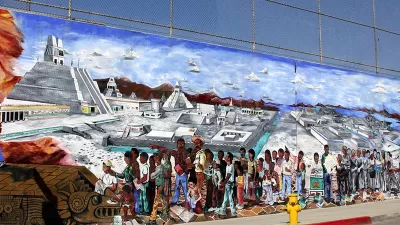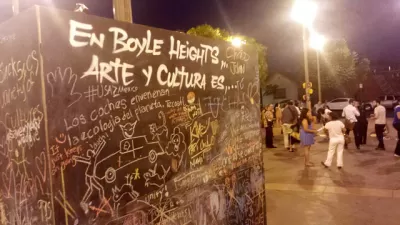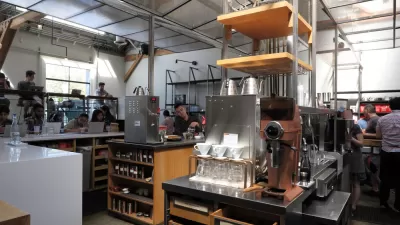A show about the impacts of gentrification in a working-class immigrant neighborhood in Los Angeles is generating controversy among those it represents.

The Starz show “Vida” is about life in the Boyle Heights neighborhood of Los Angeles, where gentrification is an issue at the forefront. The show has tried to tackle this topic—along with hiring a slew of Latino actors and writers—but it now finds itself the target of anti-gentrification activists.
"The protests over the filming mark a new ironic twist, because producers of the Starz show said they were simply trying to honestly portray the debate about gentrification," reports Alejandra Reyes-Velarde. The group Defend Boyle Heights does not like the show's portrayal of the community, says Reyes-Velarde:
Their biggest complaint is that those involved are profiting off the struggles of those trying to stay in their homes. They also say the show pokes fun at them and stole the image of the Ovarian Psycos Bicycle Brigade, a grassroots group of female activists who lead bike rides in Boyle Heights to combat gentrification and other social issues.
Tanya Saracho, "Vida’s" showrunner and herself an immigrant from Mexico, says she is working to keep up an ongoing dialogue with the community because she wants the Boyle Heights world she creates on the screen to accurately depict real life.
Community response to the activists’ complaints has been mixed. “One city official who declined to be named said many of the community leaders he has spoken with have reservations about Defend Boyle Heights' decision to focus on [the show] because the show's producers have generally tried to be sensitive to the community's concerns,” says Reyes-Velarde.
FULL STORY: A TV show chronicling gentrification in Boyle Heights is protested as an example of, well, gentrification

Maui's Vacation Rental Debate Turns Ugly
Verbal attacks, misinformation campaigns and fistfights plague a high-stakes debate to convert thousands of vacation rentals into long-term housing.

Planetizen Federal Action Tracker
A weekly monitor of how Trump’s orders and actions are impacting planners and planning in America.

San Francisco Suspends Traffic Calming Amidst Record Deaths
Citing “a challenging fiscal landscape,” the city will cease the program on the heels of 42 traffic deaths, including 24 pedestrians.

Defunct Pittsburgh Power Plant to Become Residential Tower
A decommissioned steam heat plant will be redeveloped into almost 100 affordable housing units.

Trump Prompts Restructuring of Transportation Research Board in “Unprecedented Overreach”
The TRB has eliminated more than half of its committees including those focused on climate, equity, and cities.

Amtrak Rolls Out New Orleans to Alabama “Mardi Gras” Train
The new service will operate morning and evening departures between Mobile and New Orleans.
Urban Design for Planners 1: Software Tools
This six-course series explores essential urban design concepts using open source software and equips planners with the tools they need to participate fully in the urban design process.
Planning for Universal Design
Learn the tools for implementing Universal Design in planning regulations.
Heyer Gruel & Associates PA
JM Goldson LLC
Custer County Colorado
City of Camden Redevelopment Agency
City of Astoria
Transportation Research & Education Center (TREC) at Portland State University
Jefferson Parish Government
Camden Redevelopment Agency
City of Claremont





























